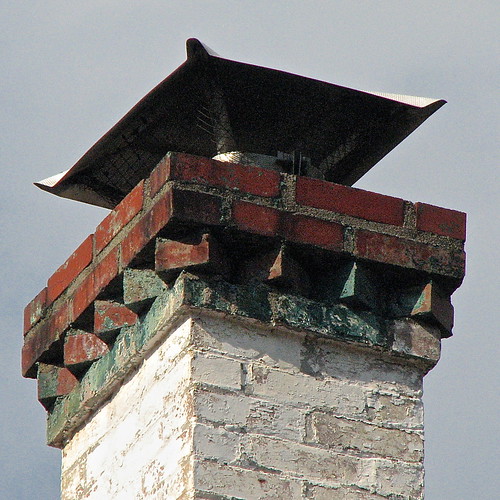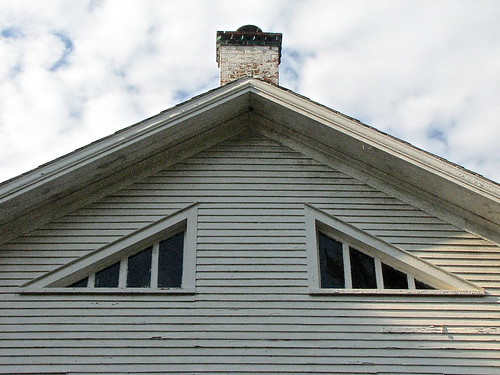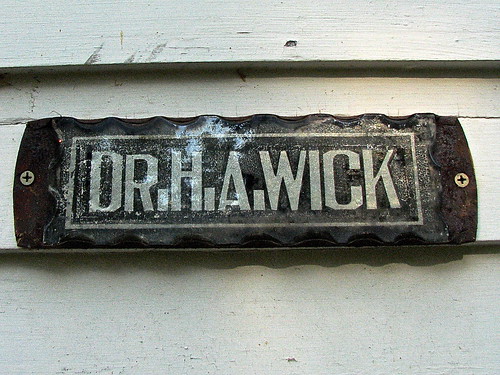Staniford (1820) / Woodbury / Eastman (1924) / Wick House – slate roof & chimney
Image by origamidon
2 Appletree Point Lane, Burlington, Vermont USA • From A Brief History of Appletree Point Farm, by Liisa Reimann for the New England Preservation Collaborative. [Note: the link is a PDF document with many informative (but low resolution) historical photographs.]:
Felix Powell, a revolutionary war soldier was the first settler in Burlington coming from Dorset in 1773. He cleared land and built a log house on Apple Tree Point.
October 22, 1774 he purchased from Samuel Averill of Litchfield, Conn. for thirty pounds a tract of land which consisted, in addition to the village lots, of 103 acre lots occupying the whole of Apple Tree Point and extending nearly to the Winooski River.
August 9, 1778 he sold the land to John Murdock of Saybrook, Conn. This deed is the first one recorded that recognized the authority of Vermont. Tablet erected on Appletree Point by the City of Burlington June 1923. …
Surveyed by the Vermont Division for Historic Preservation in June 1983, and entered onto the State Register of Historic Places as the Hilton Wick Property in 1993, the extant remains of the larger Appletree Point Farm represent a tiny sliver of what was once an extensive property covering over 300 acres and reaching from the tip of Appletree Point all the way to North Avenue. The earliest known farm on the property was that of Reuben F. Staniford, and it is his farmhouse that is thought to be within the structure that is known as the Wick House. Indeed, two additional buildings thought to be remnants of Staniford's farm are still extant. The farm's most prominent owners after Staniford were Urban A. Woodbury II, grandson of Governor Urban Andrain Woodbury, and Dr. Oliver N. Eastman, whose descendants still own several properties on Appletree Point. …
Charles Woodbury hired prominent Burlington architect Louis Sheldon Newton to remodel the old farmhouse. Sheldon began sketching his designs in 1922, and in 1924 the remodel was executed. Between September and November 1924, Sheldon spent roughly ninety hours on and off-site working on the design, which included interior and exterior changes, [the Southern Plantation portico recently removed, though evidence remains] as well as the addition of the ell and garage. A new primary entrance door was designed of clear pine, and Woodbury was given two options for the transom and sidelights. W.S. Hutchinson Screens and Weather Strips of Boston outfitted "(6) double hung windows, (1) single and (2) pairs of doors" with Higgin Zinc Metal Weather Strips. Newton's fee was 3.91, with an additional .40 assessed for travel expenses. Blueprints, printed by McIntosh and Crandall, cost .90 Sheldon invoiced Charles for the 1922 sketches and the 1924 execution of work on November 28, 1924, upon completion of the project
Woodbury, for some reason, delayed payment to the architect. On December 10, 1924 Sheldon sent Charles a request for payment. A second letter followed on December. Woodbury still had not settled his bill more than four years later — a letter dated January 24, 1929 again asks Charles to "in a sense of right and honor … send me a check for the face of the bill and settle the account."
…
[Oliver Eastman operated a farm and dairy operation from this house] until 1961, when he announced "farming within the limits of a city was never attractive at any time." … The last private owner of the former estate was Burlington lawyer Hilton A. Wick.
Staniford (1820) / Woodbury / Eastman (1924) / Wick House – elaborated chimney top
Image by origamidon
2 Appletree Point Lane, Burlington, Vermont USA • From A Brief History of Appletree Point Farm, by Liisa Reimann for the New England Preservation Collaborative. [Note: the link is a PDF document with many informative (but low resolution) historical photographs.]:
Felix Powell, a revolutionary war soldier was the first settler in Burlington coming from Dorset in 1773. He cleared land and built a log house on Apple Tree Point.
October 22, 1774 he purchased from Samuel Averill of Litchfield, Conn. for thirty pounds a tract of land which consisted, in addition to the village lots, of 103 acre lots occupying the whole of Apple Tree Point and extending nearly to the Winooski River.
August 9, 1778 he sold the land to John Murdock of Saybrook, Conn. This deed is the first one recorded that recognized the authority of Vermont. Tablet erected on Appletree Point by the City of Burlington June 1923. …
Surveyed by the Vermont Division for Historic Preservation in June 1983, and entered onto the State Register of Historic Places as the Hilton Wick Property in 1993, the extant remains of the larger Appletree Point Farm represent a tiny sliver of what was once an extensive property covering over 300 acres and reaching from the tip of Appletree Point all the way to North Avenue. The earliest known farm on the property was that of Reuben F. Staniford, and it is his farmhouse that is thought to be within the structure that is known as the Wick House. Indeed, two additional buildings thought to be remnants of Staniford's farm are still extant. The farm's most prominent owners after Staniford were Urban A. Woodbury II, grandson of Governor Urban Andrain Woodbury, and Dr. Oliver N. Eastman, whose descendants still own several properties on Appletree Point. …
Charles Woodbury hired prominent Burlington architect Louis Sheldon Newton to remodel the old farmhouse. Sheldon began sketching his designs in 1922, and in 1924 the remodel was executed. Between September and November 1924, Sheldon spent roughly ninety hours on and off-site working on the design, which included interior and exterior changes, [the Southern Plantation portico recently removed, though evidence remains] as well as the addition of the ell and garage. A new primary entrance door was designed of clear pine, and Woodbury was given two options for the transom and sidelights. W.S. Hutchinson Screens and Weather Strips of Boston outfitted "(6) double hung windows, (1) single and (2) pairs of doors" with Higgin Zinc Metal Weather Strips. Newton's fee was 3.91, with an additional .40 assessed for travel expenses. Blueprints, printed by McIntosh and Crandall, cost .90 Sheldon invoiced Charles for the 1922 sketches and the 1924 execution of work on November 28, 1924, upon completion of the project
Woodbury, for some reason, delayed payment to the architect. On December 10, 1924 Sheldon sent Charles a request for payment. A second letter followed on December. Woodbury still had not settled his bill more than four years later — a letter dated January 24, 1929 again asks Charles to "in a sense of right and honor … send me a check for the face of the bill and settle the account."
…
[Oliver Eastman operated a farm and dairy operation from this house] until 1961, when he announced "farming within the limits of a city was never attractive at any time." … The last private owner of the former estate was Burlington lawyer Hilton A. Wick.
Staniford (1820) / Woodbury / Eastman (1924) / Wick House – gable triangular windows
Image by origamidon
2 Appletree Point Lane, Burlington, Vermont USA • From A Brief History of Appletree Point Farm, by Liisa Reimann for the New England Preservation Collaborative. [Note: the link is a PDF document with many informative (but low resolution) historical photographs.]:
Felix Powell, a revolutionary war soldier was the first settler in Burlington coming from Dorset in 1773. He cleared land and built a log house on Apple Tree Point.
October 22, 1774 he purchased from Samuel Averill of Litchfield, Conn. for thirty pounds a tract of land which consisted, in addition to the village lots, of 103 acre lots occupying the whole of Apple Tree Point and extending nearly to the Winooski River.
August 9, 1778 he sold the land to John Murdock of Saybrook, Conn. This deed is the first one recorded that recognized the authority of Vermont. Tablet erected on Appletree Point by the City of Burlington June 1923. …
Surveyed by the Vermont Division for Historic Preservation in June 1983, and entered onto the State Register of Historic Places as the Hilton Wick Property in 1993, the extant remains of the larger Appletree Point Farm represent a tiny sliver of what was once an extensive property covering over 300 acres and reaching from the tip of Appletree Point all the way to North Avenue. The earliest known farm on the property was that of Reuben F. Staniford, and it is his farmhouse that is thought to be within the structure that is known as the Wick House. Indeed, two additional buildings thought to be remnants of Staniford's farm are still extant. The farm's most prominent owners after Staniford were Urban A. Woodbury II, grandson of Governor Urban Andrain Woodbury, and Dr. Oliver N. Eastman, whose descendants still own several properties on Appletree Point. …
Charles Woodbury hired prominent Burlington architect Louis Sheldon Newton to remodel the old farmhouse. Sheldon began sketching his designs in 1922, and in 1924 the remodel was executed. Between September and November 1924, Sheldon spent roughly ninety hours on and off-site working on the design, which included interior and exterior changes, [the Southern Plantation portico recently removed, though evidence remains] as well as the addition of the ell and garage. A new primary entrance door was designed of clear pine, and Woodbury was given two options for the transom and sidelights. W.S. Hutchinson Screens and Weather Strips of Boston outfitted "(6) double hung windows, (1) single and (2) pairs of doors" with Higgin Zinc Metal Weather Strips. Newton's fee was 3.91, with an additional .40 assessed for travel expenses. Blueprints, printed by McIntosh and Crandall, cost .90 Sheldon invoiced Charles for the 1922 sketches and the 1924 execution of work on November 28, 1924, upon completion of the project
Woodbury, for some reason, delayed payment to the architect. On December 10, 1924 Sheldon sent Charles a request for payment. A second letter followed on December. Woodbury still had not settled his bill more than four years later — a letter dated January 24, 1929 again asks Charles to "in a sense of right and honor … send me a check for the face of the bill and settle the account."
…
[Oliver Eastman operated a farm and dairy operation from this house] until 1961, when he announced "farming within the limits of a city was never attractive at any time." … The last private owner of the former estate was Burlington lawyer Hilton A. Wick.
Staniford (1820) / Woodbury / Eastman (1924) / Wick House – stored slate
Image by origamidon
2 Appletree Point Lane, Burlington, Vermont USA • From A Brief History of Appletree Point Farm, by Liisa Reimann for the New England Preservation Collaborative. [Note: the link is a PDF document with many informative (but low resolution) historical photographs.]:
Felix Powell, a revolutionary war soldier was the first settler in Burlington coming from Dorset in 1773. He cleared land and built a log house on Apple Tree Point.
October 22, 1774 he purchased from Samuel Averill of Litchfield, Conn. for thirty pounds a tract of land which consisted, in addition to the village lots, of 103 acre lots occupying the whole of Apple Tree Point and extending nearly to the Winooski River.
August 9, 1778 he sold the land to John Murdock of Saybrook, Conn. This deed is the first one recorded that recognized the authority of Vermont. Tablet erected on Appletree Point by the City of Burlington June 1923. …
Surveyed by the Vermont Division for Historic Preservation in June 1983, and entered onto the State Register of Historic Places as the Hilton Wick Property in 1993, the extant remains of the larger Appletree Point Farm represent a tiny sliver of what was once an extensive property covering over 300 acres and reaching from the tip of Appletree Point all the way to North Avenue. The earliest known farm on the property was that of Reuben F. Staniford, and it is his farmhouse that is thought to be within the structure that is known as the Wick House. Indeed, two additional buildings thought to be remnants of Staniford's farm are still extant. The farm's most prominent owners after Staniford were Urban A. Woodbury II, grandson of Governor Urban Andrain Woodbury, and Dr. Oliver N. Eastman, whose descendants still own several properties on Appletree Point. …
Charles Woodbury hired prominent Burlington architect Louis Sheldon Newton to remodel the old farmhouse. Sheldon began sketching his designs in 1922, and in 1924 the remodel was executed. Between September and November 1924, Sheldon spent roughly ninety hours on and off-site working on the design, which included interior and exterior changes, [the Southern Plantation portico recently removed, though evidence remains] as well as the addition of the ell and garage. A new primary entrance door was designed of clear pine, and Woodbury was given two options for the transom and sidelights. W.S. Hutchinson Screens and Weather Strips of Boston outfitted "(6) double hung windows, (1) single and (2) pairs of doors" with Higgin Zinc Metal Weather Strips. Newton's fee was 3.91, with an additional .40 assessed for travel expenses. Blueprints, printed by McIntosh and Crandall, cost .90 Sheldon invoiced Charles for the 1922 sketches and the 1924 execution of work on November 28, 1924, upon completion of the project
Woodbury, for some reason, delayed payment to the architect. On December 10, 1924 Sheldon sent Charles a request for payment. A second letter followed on December. Woodbury still had not settled his bill more than four years later — a letter dated January 24, 1929 again asks Charles to "in a sense of right and honor … send me a check for the face of the bill and settle the account."
…
[Oliver Eastman operated a farm and dairy operation from this house] until 1961, when he announced "farming within the limits of a city was never attractive at any time." … The last private owner of the former estate was Burlington lawyer Hilton A. Wick.
Staniford (1820) / Woodbury / Eastman (1924) / Wick House – occupant sign
Image by origamidon
2 Appletree Point Lane, Burlington, Vermont USA • From A Brief History of Appletree Point Farm, by Liisa Reimann for the New England Preservation Collaborative. [Note: the link is a PDF document with many informative (but low resolution) historical photographs.]:
Felix Powell, a revolutionary war soldier was the first settler in Burlington coming from Dorset in 1773. He cleared land and built a log house on Apple Tree Point.
October 22, 1774 he purchased from Samuel Averill of Litchfield, Conn. for thirty pounds a tract of land which consisted, in addition to the village lots, of 103 acre lots occupying the whole of Apple Tree Point and extending nearly to the Winooski River.
August 9, 1778 he sold the land to John Murdock of Saybrook, Conn. This deed is the first one recorded that recognized the authority of Vermont. Tablet erected on Appletree Point by the City of Burlington June 1923. …
Surveyed by the Vermont Division for Historic Preservation in June 1983, and entered onto the State Register of Historic Places as the Hilton Wick Property in 1993, the extant remains of the larger Appletree Point Farm represent a tiny sliver of what was once an extensive property covering over 300 acres and reaching from the tip of Appletree Point all the way to North Avenue. The earliest known farm on the property was that of Reuben F. Staniford, and it is his farmhouse that is thought to be within the structure that is known as the Wick House. Indeed, two additional buildings thought to be remnants of Staniford's farm are still extant. The farm's most prominent owners after Staniford were Urban A. Woodbury II, grandson of Governor Urban Andrain Woodbury, and Dr. Oliver N. Eastman, whose descendants still own several properties on Appletree Point. …
Charles Woodbury hired prominent Burlington architect Louis Sheldon Newton to remodel the old farmhouse. Sheldon began sketching his designs in 1922, and in 1924 the remodel was executed. Between September and November 1924, Sheldon spent roughly ninety hours on and off-site working on the design, which included interior and exterior changes, [the Southern Plantation portico recently removed, though evidence remains] as well as the addition of the ell and garage. A new primary entrance door was designed of clear pine, and Woodbury was given two options for the transom and sidelights. W.S. Hutchinson Screens and Weather Strips of Boston outfitted "(6) double hung windows, (1) single and (2) pairs of doors" with Higgin Zinc Metal Weather Strips. Newton's fee was 3.91, with an additional .40 assessed for travel expenses. Blueprints, printed by McIntosh and Crandall, cost .90 Sheldon invoiced Charles for the 1922 sketches and the 1924 execution of work on November 28, 1924, upon completion of the project
Woodbury, for some reason, delayed payment to the architect. On December 10, 1924 Sheldon sent Charles a request for payment. A second letter followed on December. Woodbury still had not settled his bill more than four years later — a letter dated January 24, 1929 again asks Charles to "in a sense of right and honor … send me a check for the face of the bill and settle the account."
…
[Oliver Eastman operated a farm and dairy operation from this house] until 1961, when he announced "farming within the limits of a city was never attractive at any time." … The last private owner of the former estate was Burlington lawyer Hilton A. Wick.
No comments:
Post a Comment